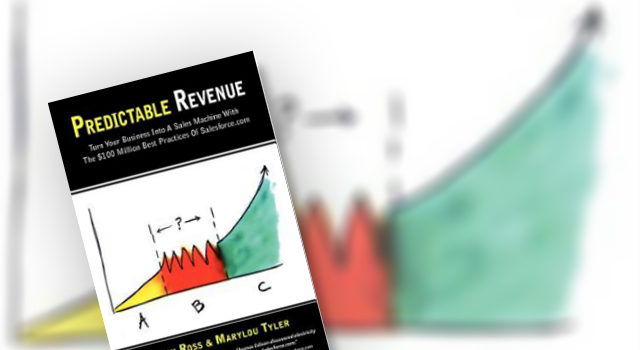Predictable Revenue: Turn Your Business Into a Sales Machine with the $100 Million Best Practices of Salesforce.com by Aaron Ross presents an innovative approach to growing a business by presenting a new system to seek more highly qualified leads, and ensure the sales team is structured to nurture them to increase the likelihood of a deal being made.
This short synopsis picks out two of the key learnings.
10 Second Summary
Predictable Revenue is based on the key findings of author Aaron Ross during his time at Salesforce.com. The book introduces a new method of outbound prospecting using Cold Calling 2.0 – a proven process that involves smart preparation and specialised sales roles to find and nurture highly qualified leads that are more likely to convert.
Key Reason You Should Read this Book
If you think there are opportunities to make your sale process more productive, this book is well worth a read. Inside you’ll discover the reason for specialising your sales teams, as well as discovering why Cold Calling 2.0 will “lead to faster sales cycles and higher win rates.”
Rapid Fire Overview of Key Sales Lessons Discussed
For me, the two key lessons from this book are the discussion of two powerful sales techniques:
1. Specialise Your Sales Force
Ross makes a very convincing argument for the benefits of specialising the jobs that individual sales reps do. He suggests if you expect a rep to do everything – from prospecting to nurturing and closing – the lack of focus leads to inefficiencies (and frustration).
Instead, break the sales process into three key selling roles. These are:
- Qualifying inbound leads
- Outbound prospecting to secure new leads
- Nurturing qualified leads
What this process does is focus on quality instead of quantity. Any new inbound opportunities are qualified to eliminate poor prospects.
Next, outbound prospecting, using Cold Calling 2.0 as a sales technique, increases the number of highly qualified leads sitting in the sales pipeline.
Finally, high quality leads are passed onto an account executive (or whatever name is relevant for your business), whose purpose is to nurture and close. And the end result is more sales.
2. Use Cold Calling 2.0
The second lesson is to use what Ross calls “Cold Calling 2.0”.
Whilst at Salesforce.com, Ross saw that traditionally outbound prospecting, including strategies such as cold calling, wasted a lot of time and effort and led to frustration because it was difficult to reach the decision maker. In addition, it’s often the case that the eventual decision maker simply isn’t the right point of contact for that initial prospecting call.
But as most sales reps know, if you can locate the right contact and prove you have something of value that can help, your ability to engage in a meaningful sales conversation increases significantly.
Ross experimented with making initial contact via email. In the book, Ross explains how he tested two forms of email – the traditional “salesy” type message against the “short and sweet” version that asked for a referral to the right person (more guidelines on how to structure your email for maximum impact can be found in the book). Interestingly, the “short and sweet” email outperformed the first – significantly. Ross also makes a suggestion of the best time to click send.
“Send the messages either before 9am or after 5pm, and avoid Mondays and Fridays. (Sundays are OK.)”
In addition, he explored the impact of a “preparation phase” that took place in advance of the emails. This involved identifying potential customers and building a list of contacts. The list contained prospects who were similar to existing customers – and were therefore likely to be a good match.
Finally, once the right point of contact was identified, highly qualified leads were passed onto an account executive to nurture and close.
In this sense, Cold Calling 2.0 has three clearly defined stages:
- Prepare: This is to ensure “smart targeting” and involves building a list of target accounts and contacts that fit your “Ideal Customer Profile” to enable you to find the right leads quicker AND disqualify unsuitable prospects
- Prospect: Send non-salesy “short and sweet” emails focused on locating the right people (people who fit the ideal client profile, have influence and are interested in the next step) with whom you can set up a first conversation
- Begin sales cycle: Finally, pass the baton to “businesspeople who can sell”, and task them with engaging prospects in the right kind of conversations that will lead to a close
Suggestions as to How You Can Apply These Insights to Your Sales Techniques
As a company looking to grow, the lessons contained in this book are well worth exploring. In particular, the concept of specialising your sales force and allowing different types of reps to focus on specific pipeline jobs could have a significant impact on your overall success. In addition, Ross’ thoughts on a new type of cold calling as a sales technique are well worth experimenting with. Imagine the impact on your business if you were able to increase the quality of your leads by implementing a simple, proven system that can shortcut your way to the decision maker?
How do you get the most from your sales force? What tactics and techniques have you tried to ensure you’re not wasting time speaking with the wrong people? Please share your thoughts and ideas in the comments below.










